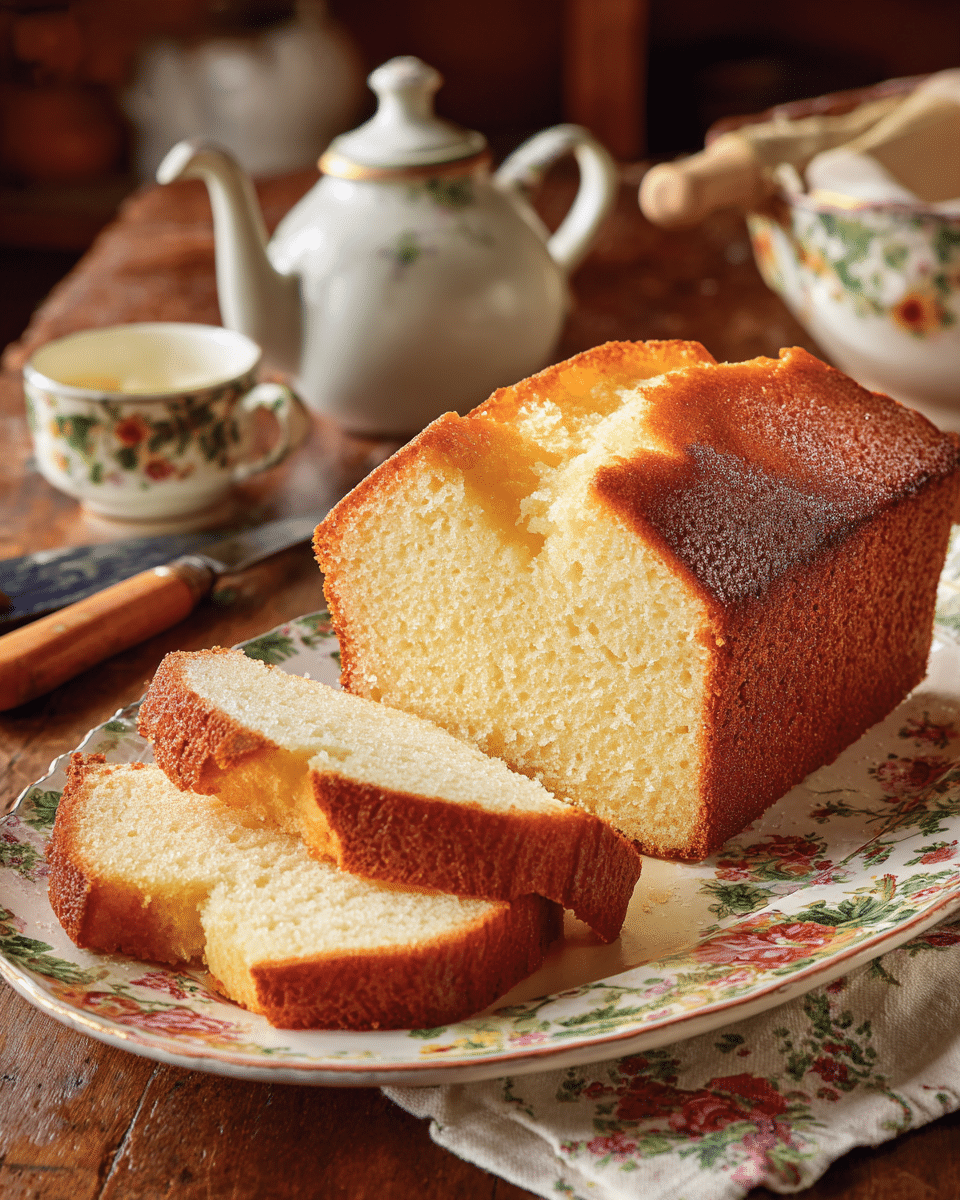This Perfect Pound Cake recipe brings the nostalgic warmth of Grandma’s kitchen into your home. With its delicate crumb, rich buttery flavor, and golden crust, this cake is a timeless classic that never fails to impress. Traditionally made with a pound each of butter, sugar, eggs, and flour, this version has been refined to produce a fluffier, moister texture without losing its traditional charm.
FULL RECIPE
Ingredients
- 1 cup (226g) unsalted butter, softened
- 1 1/2 cups (300g) granulated sugar
- 4 large eggs, room temperature
- 2 cups (240g) all-purpose flour
- 1/2 teaspoon baking powder
- 1/2 teaspoon salt
- 1/2 cup (120ml) whole milk, room temperature
- 2 teaspoons vanilla extract
- Optional: 1 tablespoon lemon zest or almond extract for flavor variation
Directions
- Preheat oven to 325°F (163°C). Grease and flour a 9×5-inch loaf pan or line with parchment paper.
- In a large mixing bowl, cream the softened butter and sugar together using a hand or stand mixer on medium-high speed until light and fluffy, about 3–5 minutes.
- Add eggs one at a time, beating well after each addition. Scrape down the bowl as needed to ensure even mixing.
- In a separate bowl, sift together the flour, baking powder, and salt.
- Gradually add the dry ingredients to the wet mixture, alternating with the milk, starting and ending with the flour mixture. Mix on low speed until just combined.
- Stir in vanilla extract and any optional flavorings like lemon zest or almond extract.
- Pour the batter into the prepared pan and smooth the top with a spatula.
- Bake for 60–70 minutes, or until a toothpick inserted into the center comes out clean.
- Allow the cake to cool in the pan for 10–15 minutes, then remove and let it cool completely on a wire rack.
- Slice and serve plain or with toppings like powdered sugar, glaze, berries, or whipped cream.
Nutrition Facts
- Calories: 360
- Total Fat: 20g
- Saturated Fat: 12g
- Cholesterol: 110mg
- Sodium: 180mg
- Total Carbohydrates: 39g
- Dietary Fiber: 0.5g
- Sugars: 24g
- Protein: 5g
- Calcium: 30mg
- Iron: 1.2mg
- Vitamin A: 600 IU
- Vitamin C: 0mg
Texture and Structure: What Makes It ‘Perfect’
A truly perfect pound cake achieves the ideal balance of density and softness. The crumb should be fine yet moist, with a slight bounce that makes each bite feel indulgent. Achieving this texture relies on proper creaming of the butter and sugar to incorporate air, careful addition of eggs, and alternating dry and wet ingredients to avoid overmixing. The addition of a small amount of baking powder in modern recipes helps the cake rise gently while preserving its traditionally dense structure, leading to a loaf that slices cleanly and evenly.
Flavor Profile and Customization Options
While classic pound cake highlights the natural flavors of butter, eggs, and vanilla, it also serves as a blank canvas for creative twists. Adding lemon zest gives the cake a bright, fresh note, while almond extract introduces a nutty warmth. For those who enjoy richer undertones, swapping part of the vanilla extract with rum or bourbon can add depth. Cocoa powder, shredded coconut, citrus glazes, or even espresso powder can be used to build layers of flavor without compromising the base structure of the cake.
Serving Suggestions for Any Occasion
The beauty of pound cake is that it fits seamlessly into any setting, from casual snacks to elegant desserts. Sliced and served plain, it makes a delightful companion to a cup of tea or coffee. For a more decadent presentation, it can be topped with whipped cream, fresh berries, or a drizzle of chocolate or caramel sauce. Toasting slices slightly in a skillet or oven intensifies their buttery flavor and adds a crisp edge, perfect for brunches or as the base for shortcake-style desserts.
Ideal Pairings to Enhance Flavor
Pound cake pairs wonderfully with a variety of flavors and textures. Tangy fruits like strawberries, raspberries, and blueberries provide a vibrant contrast to its richness, while whipped cream or Greek yogurt adds lightness. For a fall or winter twist, cinnamon-spiced apples or poached pears work beautifully. Beverages like black coffee, Earl Grey tea, or dessert wines such as Moscato or port are excellent complements, enhancing the cake’s natural sweetness and creating a balanced dessert experience.
Tips for Baking Success
Consistency is key when baking pound cake. All ingredients should be at room temperature, especially butter, eggs, and milk, to ensure even mixing and prevent curdling. Overmixing is a common issue that can lead to a tough or dry texture, so it’s important to mix just until the ingredients are combined. Proper greasing and flouring of the loaf pan helps prevent sticking and allows the cake to release cleanly. Using an oven thermometer can also help, as many home ovens run hotter or cooler than their settings suggest, affecting bake times and outcomes.
Storage and Shelf Life
Pound cake stores exceptionally well, which makes it a convenient make-ahead option. Once fully cooled, it should be wrapped tightly in plastic wrap or stored in an airtight container at room temperature for up to four days. Refrigeration can slightly dry out the texture, but if necessary, it can be done to extend freshness. For longer storage, pound cake freezes beautifully. Wrap individual slices or the whole loaf in plastic and foil, then freeze for up to three months. Thaw at room temperature for a few hours before serving.
Using Pound Cake in Other Desserts
Beyond enjoying it as-is, pound cake can be repurposed into other desserts. Cubed and layered with custard, fruit, and cream, it becomes the foundation for an easy trifle. Toasted and topped with ice cream and sauce, it makes a quick gourmet treat. Leftover slices can be turned into French toast or bread pudding, offering a second life for any extra servings. Pound cake’s sturdiness and moisture retention make it a great candidate for any dish requiring a cake base that won’t become soggy or fall apart.
Making It Seasonal or Festive
With just a few changes, this classic cake can be tailored for different holidays and seasonal gatherings. In spring, fresh lemon zest or lavender can create a light, floral flavor. For summer picnics, top it with berries and whipped cream. Come fall, mix in cinnamon and nutmeg or swirl in pumpkin puree for a cozy twist. During the holidays, pound cake can be glazed with a spiced rum syrup or studded with dried fruits and nuts to mimic the flavor of fruitcake without its heaviness.
Healthier Alternatives and Adjustments
Though traditional pound cake is rich in butter and sugar, small modifications can lighten it up. Using Greek yogurt or sour cream in place of part of the butter adds moisture and tang without extra fat. Substituting half of the all-purpose flour with whole wheat pastry flour can increase fiber while preserving tenderness. For those reducing sugar intake, alternative sweeteners like stevia-blend products or coconut sugar can be used carefully to maintain structure and flavor. While these versions may not be identical to the original, they still offer delicious, satisfying results.
Advertisement
Conclusion
The Perfect Pound Cake is a timeless dessert that continues to charm both novice bakers and seasoned pros with its rich flavor, smooth crumb, and irresistible aroma. Its adaptability, from flavor variations to serving styles, ensures it remains relevant across generations and occasions. Whether it’s part of a family recipe collection, a holiday tradition, or simply a comforting afternoon treat, pound cake holds a special place in the heart of home baking. With the right techniques and thoughtful ingredients, it truly lives up to its name—perfect in every slice.






